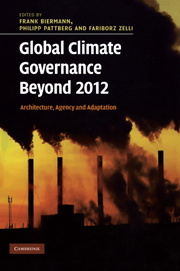Book contents
- Frontmatter
- Contents
- List of contributors
- Preface
- List of abbreviations
- 1 Global climate governance beyond 2012
- Part I Architecture
- 2 The architecture of global climate governance
- 3 The consequences of a fragmented climate governance architecture
- 4 Environmental effectiveness and economic consequences of fragmented versus universal regimes
- 5 Developing the international carbon market beyond 2012
- 6 The overlap between the UN climate regime and the World Trade Organization
- 7 An architecture for long-term climate change
- 8 Shaping the architecture of future climate governance
- Part II Agency
- Part III Adaptation
- Index
- References
7 - An architecture for long-term climate change
North–South cooperation based on equity and common but differentiated responsibilities
Published online by Cambridge University Press: 05 July 2014
- Frontmatter
- Contents
- List of contributors
- Preface
- List of abbreviations
- 1 Global climate governance beyond 2012
- Part I Architecture
- 2 The architecture of global climate governance
- 3 The consequences of a fragmented climate governance architecture
- 4 Environmental effectiveness and economic consequences of fragmented versus universal regimes
- 5 Developing the international carbon market beyond 2012
- 6 The overlap between the UN climate regime and the World Trade Organization
- 7 An architecture for long-term climate change
- 8 Shaping the architecture of future climate governance
- Part II Agency
- Part III Adaptation
- Index
- References
Summary
Introduction
The pace of climate negotiations needs to step up significantly to deal with the urgency of the challenge. This chapter considers different proposals or ‘packages’ for a possible architecture for the future of the climate regime beyond 2012. In terms of the appraisal question for Part I of this volume (Biermann et al., this volume, Chapter 2), this chapter analyses proposals that fall between a state of ‘cooperative fragmentation’, namely the status quo of the UN climate regime, and the ideal type of ‘universalism’, that is, an all-encompassing regime. Unlike the contributions by Hof et al. (this volume, Chapter 4) and Flachsland et al. (this volume, Chapter 5), the chief assessment criterion in this chapter is the principle of equity. It is the first principle cited in the United Nations Framework Convention on Climate Change. Article 3.1 states: ‘The parties should protect the climate system for the benefit of present and future generations of humankind, on the basis of equity and in accordance with their common but differentiated responsibilities and respective capabilities’ (UNFCCC 1992).
The objective of the climate convention as spelled out in article 2 is not only about stabilization of concentrations of greenhouse gases. This objective must be achieved in a way that does not prejudice sustainable development. From the perspective of developing countries, ensuring that economic development can proceed in a sustainable manner remains as relevant as ever, as do social considerations and quality of life issues such as food security (UNFCCC 1992).
- Type
- Chapter
- Information
- Global Climate Governance Beyond 2012Architecture, Agency and Adaptation, pp. 97 - 115Publisher: Cambridge University PressPrint publication year: 2010
References
- 4
- Cited by



